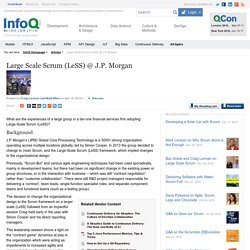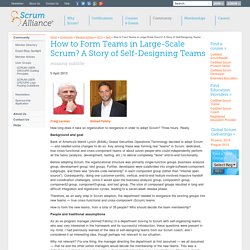

Disadvantages of Agile Development. Don’t get me wrong.

I’m a big fan of agile development. If you’re a regular reader of my blog, you’ll know that :-) But I’m not so pro-agile that I’ve lost all sense of balance. An agile approach to development is good for so many reasons. But agile development does require certain things that can also be a disadvantage. If you’re thinking of adopting agile principles, it’s important that you know what you’re in for. Here’s my list of potential disadvantages with agile: Active user involvement and close collaboration are required throughout the development cycle. I believe these trade-offs are well worthwhile. Kelly. See also:Is agile development right for your project? Home. XR4-1.pdf. Large Scale Scrum (LeSS) @ J.P. Morgan. What are the experiences of a large group in a tier-one financial services firm adopting Large-Scale Scrum (LeSS)?

Background J.P. Morgan’s (JPM) Global Core Processing Technology is a 3000+ strong organization operating across multiple locations globally, led by Simon Cooper. In 2013 the group decided to change to (real) Scrum, and the Large-Scale Scrum (LeSS) framework, which implied changes to the organizational design. Previously, “Scrum-But” and various agile engineering techniques had been used sporadically, mainly in development teams, but there had been no significant change in the existing power or group structures, or in the interaction with business -- which was still “contract negotiation” rather than “customer collaboration”. The decision to change the organizational design to the Scrum framework on a larger scale (LeSS) followed from an impactful session Craig held early in the year with Simon Cooper and his direct reporting managers.
Identification of Real Product Owners. Method Wars: Scrum vs SAFe. SAFe, LeSS, DAD, and ScrumPLOP - Lean Agile Training. October 20, 2013 First, I wanted to say that I feel each ‘large scale agile’ situation is different.

The key problems are different. And therefore, the solution(s) should be different. And I like the idea of patterns. This is the patterns idea: “Here are some things (patterns) that others have found useful, and maybe I can steal from them, and maybe even these things (patterns) will be useful for me.” One of the nice things about patterns is that they start modestly.
Here are some places where you can steal (in a nice way). SAFe. LeSS. DAD. ScrumPLOP. I hope these resources are useful to you. Again, I wish to remind you and caution you: Do not forget the individual team(s). If you have great scaling and bad teams, you have almost nothing. . « « Why I prefer ‘Release Plan Refactoring’ to ‘grooming’ || ALN RDU: Joe’s Agile Release Planning » » How to Form Teams in Large-Scale Scrum? A Story of Self-Designing Teams - Scrum Alliance. How long does it take an organization to reorganize in order to adopt Scrum?

Three hours. Really. Background and goal Bank of America's Merrill Lynch (BAML) Global Securities Operations Technology decided to adopt Scrum — and needed some changes to do so. Key among these was forming real "teams" in Scrum: dedicated, true cross-functional and cross-component teams of about seven people who could independently perform all the tasks (analysis, development, testing, etc.) to deliver completely "done" end-to-end functionality. Before adopting Scrum, the organizational structure was primarily single-function groups (business analysis group, development group, test group).
Therefore, as an early step in Scrum adoption, the department needed to reorganize the existing groups into new teams — true cross-functional and cross-component (Scrum) teams. How to form the new teams, from a total of 35 people? People and traditional assumptions Why not relevant? The "Big Day" Large Scale Scrum (LeSS) @ J.P. Morgan.